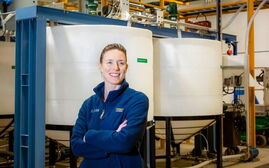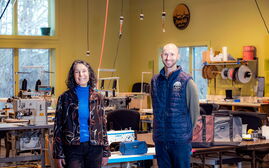Seed capital program nears depletion
Quietly and without fanfare, a state program on the books since 1989 has helped bring scarce venture capital to startup manufacturing companies in Maine.
The Maine Seed Capital Tax Credit Program, administered by the Finance Authority of Maine, has helped 50 small companies launch new lines of business since 2008, but has now nearly exhausted its $30 million cap, leading its advocates to strategize about how to keep the program viable.
To date, 2008 was the biggest year for seed capital investments, with nearly $4 million brought into small companies, which must have less than $3 million a year in revenue to qualify. The credit itself, up to 50%, must be taken over four years and amount to no more than half the investor's income tax liability in Maine.
Dick McGoldrick, a Portland developer who describes himself as a “serial investor” in small enterprises, is bullish on raising the cap, after seeing the program work during the period he served as FAME board chairman, from 2000-02.
He's written to the LePage administration advocating inclusion of a new $5 million allocation in the next biennial budget, noting that, with the credit taken over four years, it would add no more than $1.25 million to annual spending.
According to Beth Bordowitz, current CEO at FAME, the program is now within $1.75 million of the cap, and given that at least 80 companies are eligible for the credit but have not yet claimed it, the cap could be reached at any time.
Other supporters are more cautious. They say it's unclear whether the program's targets fit with administration's priorities, and note that having a legislator propose a cap increase could be iffy.
Bordowitz says if the administration proposed a new allocation, FAME would testify in favor before the Legislature's Taxation Committee. But if it came from a legislator's bill, she says, “We'd offer advice to the committee. Typically, in those situations, we would testify neither for nor against.”
Advocates say there's a clear need for extending the program, and cite successful legislation in 2011 that, for the first time, attempts to make it attractive to out-of-state investors. Previously, only Maine residents could take credits against their income. The new law makes the credit refundable, though only for those who have no taxable income in Maine.
The numbers on venture capital attraction are startling. Tim Agnew, who served as CEO of FAME from 1988-99 and now runs a venture capital firm himself, recently analyzed the program's impact on the state budget, which he found to be positive. He's also distributing data from PricewaterhouseCoopers that shows Maine lagging far behind its New England neighbors in venture capital (see chart below).
From 2001-09, Maine attracted only $5.08 per capita in venture capital annually, against $105.90 for New Hampshire and $430.00 for Massachusetts. Even Vermont did better, at $22.06. Numbers like this mean that Maine must offer incentives to attract the small, high-growth companies that can make a positive impact on the state's bottom line, advocates say.
Bordowitz notes that Maine's program was the first in the nation when it began 23 years ago, “and now you see a lot of small states trying to do something similar.”
As in real estate, venture capital investments are all about location, location, location. Boston and the Route 128 technology corridor have long been the magnet for investment in new, higher risk enterprises, and Agnew says that, at least in part, New Hampshire's numbers reflect its proximity to Route 128.
“But we're not that far away,” Agnew says. “Portland, at least, ought be in the running.”
Sen. Chris Rector, R-Thomaston, who chairs the Labor, Commerce, Research and Economic Development Committee, is a longtime supporter of the program and says its results are encouraging. “Fifty companies raising money is a really positive sign,” he says.
McGoldrick participated in two recent launches that used the credit. One, for Gelato Fiasco, a retailer of the Italian iced confection, raised $800,000 to expand its wholesale operations, which are now reaching major grocery chains in Portland. The other was for Pika Energy, a startup by four MIT-trained engineers that wants to produce a highly efficient small wind turbine “that beats anything on the market” for residential use, he says.
Peter Anania, owner of Anania & Associates, says the seed capital credit has been useful in at least half a dozen recent startups he's helped manage. They've ranged from new food packaging materials to a soil-polymer mix that gets nursery seedlings started quicker. The companies have been in out-of-the-way locations, too, including Boothbay, Windham and Southport.
But getting renewed funding for the tax credit is not a slam-dunk. Rep. Gary Knight, R-Livermore Falls, who co-chairs the Taxation Committee, says he sees the program as a useful addition to the state's economic development arsenal but support is far from universal among Republicans.
“There's a feeling for some that government shouldn't be interfering in the market, that investors can make up their own minds about what companies to back,” he says.
Indeed, not all startups are successful. Agnew says that one recent example was a company his investment firm, Masthead Venture Partners of Portland, had backed, called Fone Show. The idea was to create short-form, two-minute audio segments for distribution by phone. While the venture seemed promising, “it turned out to be before its time,” he says.
For skeptics, Agnew's analysis of program costs and state revenues might be reassuring. Over the eight-year period from 2004-11, the state realized $2,931 per year for each new job created, and the credits taken by investors amounted to $2,281 per year – producing a “profit” for the state budget of $649.97.
Agnew says he made some assumptions about payroll and taxes to do the analysis and described it as a work in progress. Bordowitz says FAME had not yet reviewed the numbers, but says of Agnew, “If he made assumptions, I'm sure they were done thoughtfully.”
A decision to push for more funding will be made this fall, before a new Legislature convenes. For McGoldrick, there's no doubt about the need to raise the cap. “These are the kind of jobs,” he says, “that everyone wants to have.”
Writer Douglas Rooks can be reached at editorial@mainebiz.biz.














Comments